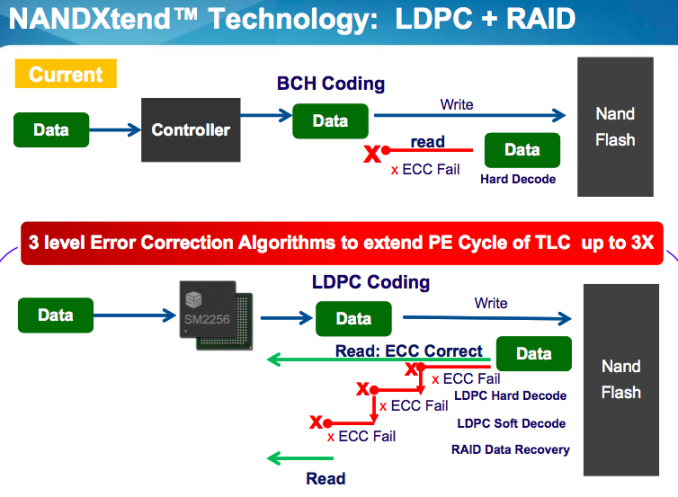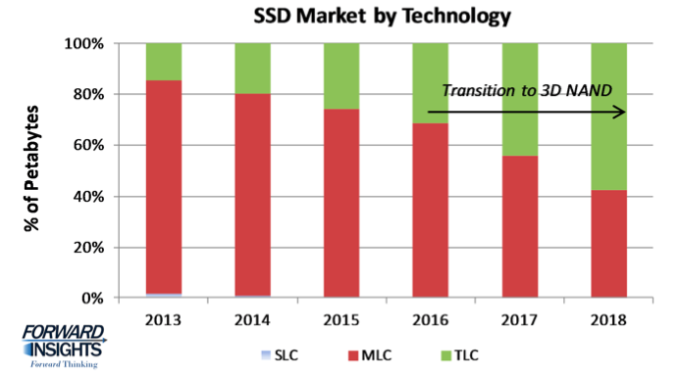FMS 2014: Silicon Motion Showcases SM2256 SSD Controller with TLC NAND Support
by Kristian Vättö on August 20, 2014 1:00 PM EST- Posted in
- Storage
- SSDs
- TLC
- Silicon Motion
- Flash Memory Summit 2014
A couple of weeks ago at Flash Memory Summit, Silicon Motion launched their next generation SATA 6Gbps SSD controller. Dubbed simply as SM2256, the new controller is the first merchant controller solution (hardware + firmware) to support TLC NAND out of the box and succeeds the SM2246 controller we tested a while ago with ADATA's Premier SP610. The SM2246 was not the fastest solution in the market but it provided decent performance at an alluring price and the SM2256 is set to lower the total cost even more thanks to support for lower cost TLC NAND.
The SM2256 continues to be a 4-channel design and I am guessing it is also based on the same single-core ARC design with most changes being in the ECC engine. NAND support includes all NAND that is currently available including Toshiba's 15nm TLC NAND and the controller is designed to support 3D NAND as well. DDR3 and DDR3L are supported for cache and the controller is also TCG Opal 1.0 compliant.
To make TLC durable enough, the SM2256 features Low Density Parity Check (LDPC) error-correction, which is a new ECC scheme that is set to replace BCH ECC. Intel did a very detailed presentation on LDPC at FMS a few years ago, although I must warn you that it is also very technical with lots of math involved. Silicon Motion calls its implementation NANDXtend and it has three steps: LDPC hard decode, soft decode and RAID data recovery. Basically, hard decode is much faster than soft decode because there is less computation involved and in case the ECC engine fails to correct a bit, the RAID data recover kicks in and the data is recovered from parity. Silicon Motion claims that its NANDXtend technology can triple the endurance of TLC NAND, making it good for ~1,500-3000 P/E cycles depending on the quality of the NAND. Marvell's upcoming 88SS1074 controller supports LDPC as well and I will be taking a deeper look at the technology once we have a sample in our hands.
TLC is expected to become the dominant NAND type in four years, so focusing on it makes perfect sense. Once the industry moves to 3D NAND, I truly expect TLC NAND to be the NAND for mainstream SSDs because the endurance should be close to 2D MLC NAND, which eliminates the biggest problem that TLC technology currently has.
The SM2256 is currently in customer evaluation and is expected to enter mass production in Q4'14 with shipping devices coming in late 2014 or early 2015.












8 Comments
View All Comments
hojnikb - Wednesday, August 20, 2014 - link
Finally more TLC love. And because more OEMs will have access to TLC capable solution, this could drive the prices down even further.serndipity - Wednesday, August 20, 2014 - link
Have wonder how much more.Just bought a Crucial MX100 256GB for $ .35/GB, shipped.
flyingpants1 - Thursday, August 21, 2014 - link
1TB for $250-300ish should be a pretty good target, IMO.akdj - Friday, August 22, 2014 - link
Pretty close @ $.035/GB. I'm thinking we aren't that far off from a dime a GB. Density with HDD continues to increase exponentially a decade ago, and today @ a nickel a GB, I don't think we're any more than five years from the $100/150 TB blades. Helluva lot less 'work' to produce NAND modules as the process becomes more commonplace than assembling HDDs, their mass, moving precision parts ....essentially a 5400, 7200 or10,000rpm 'deco cord player! Pretty amazing to me they've been as durable as most of mine have. NAMD is a different story. Manufacturing will be cheaper. Densities will continue to grow. Prices will drop as speeds increase and power, efficiency improvements along the way will continue to save energy, allowing for higher cap storage modules on phones, tablets and laptops. Pretty cool time to be using computers. HiDPI displays. Speeds of storage increasing ten fold overnight seemingly (& literally for those switching from HDD to SSD!), efficient and high power quad core CPUs and incredible iGPU innovation speed and options of I/O with USB 3/3.1 and Thunderbolt, airplay and chromecast, LTE speeds and gigabit Ethernet ISP options residentially (I'm in Alaska with Gigabit speeds from my local ISP, and it ain't Google! Lol). Amazing speeds we're moving. Literally. Both in hard and software. The options for editing photos, home video manipulation, audio recording or reading a magazine, book ...watching a flick or listening to your favorite station on the other side of the world. Flying with an iPad as your kneeboard or using a phone to capture three episodes of Nat Geo shots on four different continents! Where did time go? I'm floored by the speed of my new 15" MBP. It hauls ass. Downloading a Microsoft Office update is literally a ten second task. Batteries on laptops last all day, as do they on tablets. Pretty cool. Storage isn't falling behind. Prices will continue to come down with more manufacturers and higher densities are already available this year (TB on my MBP of PCIe SSD) is better than last years (my 2012 768). Speeds are almost twice as quick too!danjw - Wednesday, August 20, 2014 - link
". Intel did a very detailed presentation on LDPC at FMS a dew years ago, although I must warn you that it is also very technical with lots of math involved. "I think you meant: "FMS a few years ago"
Kristian Vättö - Wednesday, August 20, 2014 - link
You are correct. Thanks for the heads up :)Clorex - Saturday, August 23, 2014 - link
The article incorrectly links to the ADATA SP920 review, which uses a Marvell controller.mo miao quan - Monday, September 15, 2014 - link
I m looking forward to seeing a group of TLC SSDs with SM controller at $.25/GB.